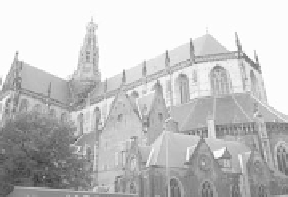Travel Reference
In-Depth Information
oVerVieW
After a fire destroyed the old church (1328), the Grote Kerk was
built over a 150-year period (c. 1390-1540) in the late Gothic style
of red and gray brick, topped with a slate-covered wood roof and a
stacked tower bearing a golden crown and a rooster weathervane.
Builders raised money by cleverly hitting up both popes—
back when there were two competing pontiffs, one in Avignon and
one in Rome. The builders came home with two different “absolu-
tion bills,” authorizing them to grant forgiveness to parishioners
for donations. Apparently, Haarlem's sinners—not knowing for
sure which pope was
the
pope—covered all their bases by giving
twice for their forgiveness.
Originally Catholic, the church was named after St. Bavo, a
local noble who frequented seventh-century Red Light Districts
during his youth. After his conversion, he moved out of his castle
and into a hollow tree, where he spent his days fasting and praying.
In the late 1500s, the St. Bavo Church became Protestant (Dutch
Reformed) along with much of the country. From then on, the
anti-saint Protestants simply called it the Great Church.
the toUr Begins
• You'll enter the church from the side opposite the square. As you walk
around the building, check out a few details...
Exterior
Notice the rough buttress anchors, which were never needed.
Money ran out, and the planned stone ceiling (which would have
required these but tresses) was
replaced by a lighter wooden one.
Some windows are bricked up
because the organ fills the wall.
The original stone tower
crowned the church from 1522
until 1530, when the church began
sinking under its weight. It was
removed a nd replaced by t he
lighter, wood-covered-with-lead version you see today. (The frugal
Dutch recycled the old tower, using it to cap the Bakenesser church,
a short walk away.)
Because the tower was used as a lookout by Napoleon, it
was classified as part of the town's defense. As a result, the tower
(but not the rest of the church) became city property, and, since
Haarlem's citizens own it, they must help pay to maintain it.
The base of the church is encrusted, barnacle-like, with




















